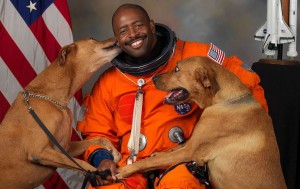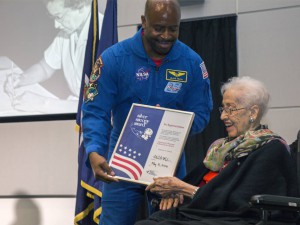From the Overview Effect to “One Strange Rock”: A Conversation with Leland Melvin
Posted on Categories Discover Magazine

Leland Melvin shows the two sides of his passion, with the wonder of the “overview” showing outside his Shuttle window. [Credit: NASA]
It’s hard to think of any modern human activity that has had more of a multiplicative impact on the imagination than space exploration. To date, a grand total of 562 humans have left the Earth—a trivial fraction compared to the 7.6 billion people currently staying put. Yet the image of astronauts voyaging away from their home planet has transformed popular culture, education, even business and politics.
Former NASA astronaut Leland Melvin is a lead agent helping to advance that transformation. In a wide range of appearances, he speaks eloquently about the “overview effect,” the life-changing cognitive shift that comes with seeing Earth from the outside. Most recently, he has participated in the new series One Strange Rock, which embraces that effect by examining the marvels of our world from astronauts’ perspectives.
If there is anyone who can bring the rewards of the overview effect to a broader audience—and help make our society a little better in the process—it is Melvin, who has proven his populist bona fides not just as a public speaker and educator, but also as a wide receiver for the Richmond Spiders…and as a noted dog lover. I spoke with Melvin about his life in space, his life in sports, and his latest efforts to share the epiphany of space exploration.
[For science news with a focus on the human adventure in space, follow me on Twitter: @coreyspowell]
Most people will never experience space travel, but you say that space training is a lot like the more familiar process of sports training. How are they similar?
Melvin: The training for flying in space and the training for the NFL, they’re so similar from a mental standpoint. You are working with a team of people to get a win. For space, getting the win means getting to space safely. In the Space Shuttle, you have four people in the cockpit working together as one unit to make sure that any malfunction that pops up, anything that happens, you can figure it out as a team, you can back each other up, and you can into space safely.
When I was a wide receiver there was a similar kind of relationship. On the fly, you have to make contact with the quarterback. A lot of times it’ll be eye contact because the screaming from the crowd can be so loud that you can’t even hear anything. When I think about doing this mind meld between the quarterback and the receiver, to change and to do things on the fly, we do the same thing in the Shuttle. There can be so much chatter going on, we may communicate non-verbally by tapping the checklist or by pointing to a bank of switches.
In both situations, there’s that connection. You just know what you’re going to do, you know what you’re going to do as team.

One way to share the feeling of being in space is by using familiar cues: sights, sounds, smells, and of course dogs. (Credit: NASA)
But only one of those situations is life or death.
Hold on, that’s not true. In the NFL, if the quarterback hangs a ball and you go after it, and someone hits you and they drive you down on your neck and you snap your neck, you could be dead, or you could be paralyzed. And with the concussion situation, if someone gets hit hard in the head, that could be lifelong trauma. It could be life-ending in the long run. It might not be as dramatic as in space, where a wrong switch throw on the Shuttle could have hydrazine leaking into an auxiliary power unit and everything explodes. But there is safety and death in both settings.
You had a scary, seemingly career-ending accident during astronaut training. What happened?
I was training In the Neutral Buoyancy Laboratory, in a pressurized suits we use to simulate spacewalking in a neutrally buoyant environment [working in an enormous, NASA-designed swimming pool]. If you’re the kind of person who needs to clear your ears by squeezing your nose with your fingers, you can’t do that because you’re enclosed in this suit with a helmet. The only you can clear is with a Styrofoam block that you put in front of your nose in your helmet, and you press your nose against it to clear your ears.
On the day of training the technician forgot to put that in. When I went down into the pool about 20 feet, I was straining and I was not able to effectively clear. They took me out, popped my helmet off, blood was coming out of my ear. Over the next three weeks my hearing started slowly coming back but my left ear was almost completely gone, and in my right ear I only have speaking frequencies. I was medically disqualified. They told me, you will never fly.
And yet you did make it into space after all. How did you recover?
I believe my brain was rewiring itself to hear again, to have noise discrimination, to be able for me to communicate effectively with others, especially my crewmates up in space. I had to use different techniques. The way that your body adjusts to trauma, it can give you other strengths when you lose something—like when you lose one arm, the other arm gets stronger. Sometimes I feel like I have a kind of Spidey sense! I probably read lips a little. Maybe there’s also a way my skin feels the vibration of communication that I can now interpret.
My episode of One Strange Rock is called Awakenings. It’s about the brain figuring out how to take all the data in with the senses to do things like getting food for your family or getting out of harm’s way. In my case, somehow I was able to hear the calls from my crewmates. When you’re doing a space walk you’ll say, maybe, move me 10 inches starboard, move me one foot port. My brain went into overdrive to make sure that I was capable of doing the task.
How does going into space change your senses? Does that experience also rewire your brain?
It does. In space, once the main engines cut out you don’t have any g’s on your body. Those little rocks in your inner ear [that sense up and down] are now ineffective. Your brain has to shut that data off. And I think people get sick from the conflict between orientations coming from the inner ear, which is wrong, and their eyes. The faster you can filter out that incorrect data, the better off you are.
Just transiting through the station, not bumping into things and knowing what orientation you’re in and how fast you’re accelerating, that body control is something that you have to gain…and it depends on the person. I think because I was an athlete–because I had all this high-end training in how to control my body, running and cutting and having to lower and raise my center of gravity–I think that helped me with my adaptation to microgravity.
What does the overview effect mean to you? Why do you consider it so important?
I want people to think about anything you’re doing that’s bigger than yourself. I think about Katherine Johnson in Hidden Figures. Her discipline and her dedication. I gave her a copy of my book and the first thing she wanted to know from me was, “When are we going to Mars? Who’s doing it?” It just blew my mind to think about this woman who challenged everything in West Virginia. She trained herself from a very little girl to be very exact.

Leland Melvin with Katherine Johnson at NASA’s Langley Research Center in 2016 (Credit: Credits: NASA/David C. Bowman)
What I want people to know is that the routine, this repetition [of learning to be precise and practiced], is done with joy. I call it the joy of repetition. It is not just about us getting a joy ride into space. It’s about bringing it back home and sharing it with people, especially with children. To share it with them so that we can make our planet a better place. We do it together as one civilization, one family. That’s what I take from my training—bringing us all together.
I’m a big advocate for STEAM [science, technology, engineering, art, math] education. If we’re all STEAM explorers, we take everything we do experientially and turn it into something good.
How can more people share that feeling of being in space?
We have to perfect a way to do it down here, because we’re not going to get millions of people in space unless some really incredible technology change happens. Nothing prepared me for it on the ground. I was in the simulators where you can see all aspects of what looks like to be in space, but you’re still in a 1-g environment.
In orbit, you’re looking out the window at Earth, and you’re doing it with people who are already from around the entire world. You’re getting this flavor of Russia as you’re flying over Russia talking to Yuri, or coming over Europe while Hans or Leo are there. You’re making a connection with the people down there because you there with someone who’s from there.
To help people share this overview effect, we will need to have–whether it’s virtually or side by side–astronauts who have been there who can tell the story of what it felt like, what it smelt, like what it tasted like. It’s a very rich part of storytelling. And then have the person’s senses being affected by what they’re seeing.
Your participation in the new series One Strange Rock is part of that?
You know, in One Strange Rock, you’re looking at it in 4K, seeing the planet from space in a very dynamic beautiful compelling way. But imagine if we could have you in a harness where you actually feel like you’re floating over to the Cupola [aboard the International Space Station] and looking out the window. Then what if you could add the other senses in there: You’d have the audio, you’d have a visual, even what it smells like on the space station.
That makes me wonder: What does it smell like in space?
It varies in different parts of the station. When you float through the FGB—the functional cargo block [of the ISS] when I was there—that’s where people will hang their gym shoes and shorts. If you’re floating through there you may catch a whiff of something pretty rich. In the laboratory it might smell a little more like mechanical stuff. Then if you go to the place where we have meals you may smell remnants of the food.
And when you’re coming from outside doing a space walk, there’s this cold metal smell of the EVA suit. Some people say it’s like the smell of sulfur, cold sulfur. But it to me it was like hot metal, but cold. It’s hard to describe.
Now imagine pumping in those smells [while watching a TV show or movie about space travel]. And also playing with temperature. If you’re now coming into the sun in orbit, coming from sunset to sunrise, maybe having the person’s face heat up. VR, sensory suits, suspending people—those are ways you can trick the body to think that you’re really in space. If you add the other senses in there think you can do some good to really help people get that shift.

The overview effect, now on the small screen courtesy of Melvin and “One Strange Rock.” (Credit: National Geographic)
Beyond One Strange Rock, what are you doing to let ordinary people have access to the overview effect?
I’m working right now with Constellation. It’s a group of international astronauts–myself, Ron Garan, Nicole Stott, and Anousheh Ansari–trying to get more people involved to tell stories and do presentations to help give that overview effect to people. We’re working on a movie called Orbital right now. We talked to a lot of Apollo astronaut, some Shuttle and Station astronauts, and we’re getting their orbital perspective: What they felt, what they saw, what they believed.
We’re going to use some of the footage to do presentations with large groups of people—to help them see, feel, and taste that overview effect. The storytelling is a huge component of it, but then adding those other sensory elements makes it even more powerful.
Douglas Trumbull [who helped develop the effects for 2001 and Blade Runner] is making little pop-up theaters that can give you all of the visual and sensory experience. You could do other things, maybe make the seats motion-activated. The visuals of what he’s doing are just incredible. He also believes that we’re not going to get enough people up there [in space] to give them the overview effect directly, but we can still help give them the shift.